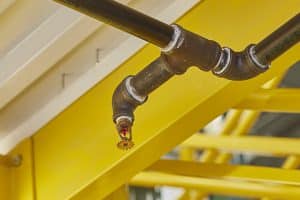Fire Protection Is a Key Part of Design of Warehouses with Pallet Racks
Posted on Jun 28, 2022
Planners Need to Be Aware of Pending Code Changes
Fire protection is always a crucial part of designing a warehouse with pallet rack systems. While capacity and efficiency are the main operational goals, the planning also needs to consider the safety of people and the protection of warehouse contents from fire.
Warehouse fires are more common than might be perceived. The National Fire Protection Association (NFPA) says there are more than 1,400 warehouse fires each year, resulting in nearly $160 million in property damage, as well as injuries and death.
Planners of sprinkler systems can expect to see significant changes in codes guiding fire protection relating to warehouse storage later this year.
The updates to NFPA 13, which relate to sprinkler systems in warehouses, are expected to be approved in September, followed by adoption into the 2024 International Building Code (IBC) and state adoption of the IBC.

Integrated fire suppression in rack system
Two big changes affecting pallet rack systems are in the updates. The biggest change in the NFPA 13 changes for 2022 could be the sprinkler head density determination, which will move away from a density/area curve calculation to a single-point method. “Density” is the amount of water that needs to be delivered every minute for every square foot of floor space. The density/area curves will still apply to the evaluation and modification of existing systems.
Another major change involves standards for multiple-row racking. Under the new rules, racking depths greater than 20 feet will fall under the “solid shelving” criteria, requiring in-rack sprinklers rather than solely utilizing “early suppression, fast response” ceiling sprinklers with flue space requirements for water to reach into rack sections. “Solid shelving” is a rack shelf that is solid, slatted or otherwise constructed in a manner that would obstruct sprinkler discharge down into the racks. These multi-row racks will also require full-depth, full-height longitudinal flues – the space between rows of pallet rack, in addition to transverse flues – the space between the stored items.
The flue requirements will present design challenges for drive-in racking, pallet-flow racking, and push-back racking systems.
The NFPA 13 changes would apply to new construction, but a local building inspector or fire marshal could determine that portions of the updated regulations could apply to existing facilities.
Warehouse Contents Classifications Remain
With those pending changes in mind, NFPA’s warehouse classification remains, based on the quantity and types of materials in the facility.
A building’s classification, along with occupancy classification, determines the sprinkler water requirements. Building size, building construction materials, and activity within the building are factors that guide the sprinkler system design. There are five warehouse content classifications:
Class I
Non-combustibles stored in single-layer cartons, such as canned foods and metal items
Class II
Non-combustible products stored in combustible containers such as wooden crates, corrugated cardboard cartons and boxes, or waxed paper containers
Class III
Combustible products made from wood, paper, or natural fiber textiles; Group C plastics; Group A or B plastics if 5% or less by weight or volume
Class IV
Includes classes I, II or III product stored in ordinary corrugated cartons or boxes, possibly palletized, containing packaging consisting of 5% to 15% Group A plastic by weight or 5% to 25% by volume
Plastics
Classified by the level of heat they release and the rate at which they burn
For NFPA purposes, internal and external packaging, and the pallet are considered when determining the classification.
Also guiding rack system design is the “high-piled combustible” section of the International Fire Code, which requires an operational permit in facilities that meet certain criteria. Those factors include storage heights greater than 12 feet, the floor area, the footprint of the racks, flue spaces and service aisles.
Two Main Types of Sprinkler Systems
Fire sprinkler systems can be classified into two main types: “prescriptive design” that basically follows NFPA guidelines, and “performance-based” systems which are custom-designed for specific applications.
Within that framework are ESFR (early suppression, fast response) ceiling sprinklers that require a 36” clearance below the sprinkler head and that are designed to eliminate the need for in-rack systems, and CMDA (control mode density area) ceiling sprinklers that are used in conjunction with in-rack sprinklers and that require an 18” clearance below the sprinkler head.
Sprinkler systems are intended to suppress fires and reduce damage and losses, while a fire department’s role is to extinguish the fire.
In-Rack System Might Be Required
If certain conditions exist, an in-rack system might be required to ensure that water can reach throughout the rack to protect stored items and to keep the temperature of racking steel below a level that would compromise its integrity. Warehouse contents classification, storage and ceiling height, flue sizes and locations amid and around the racks, the presence of solid shelves and an adequate water supply are factors that could trigger the in-rack requirement.
Because in-rack systems are much closer to warehouse activity than ceiling systems, the sprinklers need to be placed out of harm’s way while providing maximum coverage. In some locations, seismic zone regulations relating to clearances could be a factor.
Permissible egress travel distances also need to be considered in storage rack design. The allowable distances are determined by the presence or lack of a sprinkler system, clear ceiling heights and, in mega-warehouses, the presence of enclosed, fire-rated staircases.
When designing a pallet rack system, it’s best to work with a fire protection consultant who has expertise in the NFPA regulations and state and local building codes. Besides sprinkler system, a fire protection expert could also consult on fire detection systems and alarms, water sources, standpipes and hoses, and other elements of fire protection.
Read more about fire suppression and safety in a previous blog post: The Importance of Flue Space in Fire Detection.
